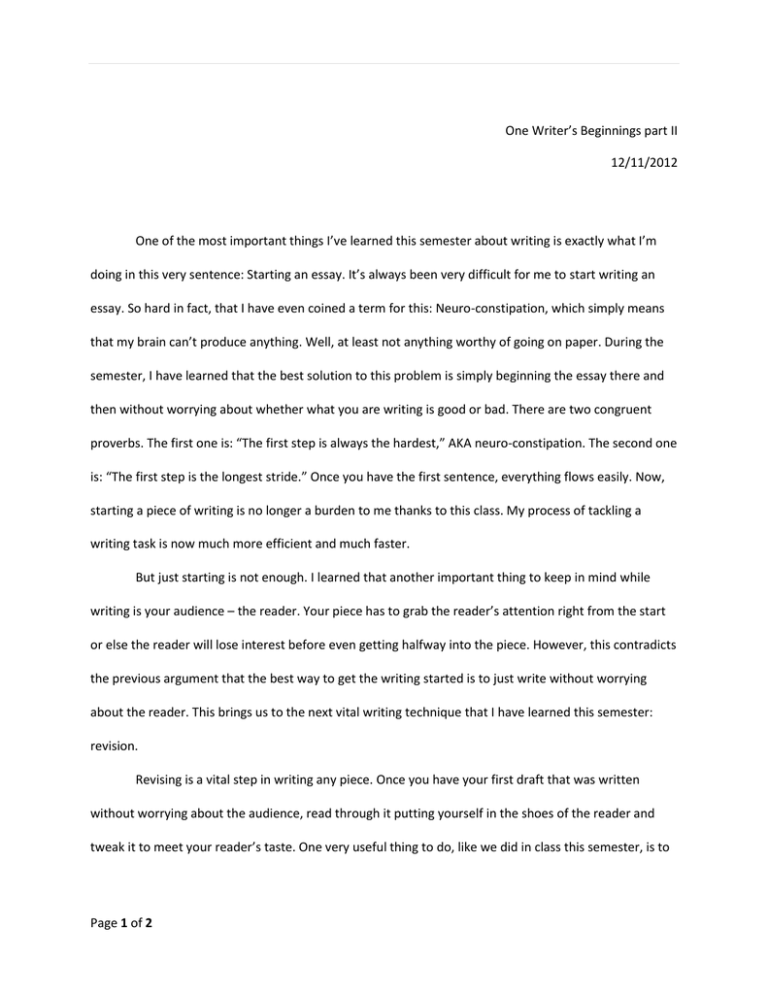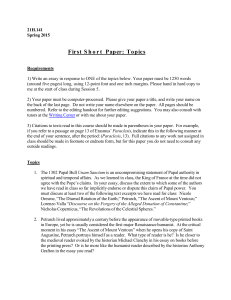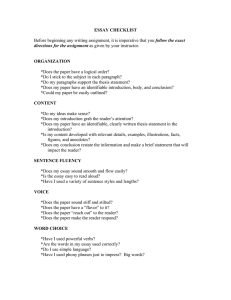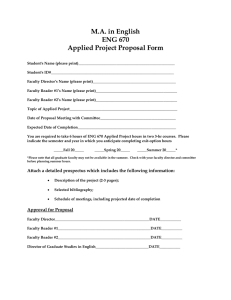One Writer’s Beginnings part II 12/11/2012
advertisement

One Writer’s Beginnings part II 12/11/2012 One of the most important things I’ve learned this semester about writing is exactly what I’m doing in this very sentence: Starting an essay. It’s always been very difficult for me to start writing an essay. So hard in fact, that I have even coined a term for this: Neuro-constipation, which simply means that my brain can’t produce anything. Well, at least not anything worthy of going on paper. During the semester, I have learned that the best solution to this problem is simply beginning the essay there and then without worrying about whether what you are writing is good or bad. There are two congruent proverbs. The first one is: “The first step is always the hardest,” AKA neuro-constipation. The second one is: “The first step is the longest stride.” Once you have the first sentence, everything flows easily. Now, starting a piece of writing is no longer a burden to me thanks to this class. My process of tackling a writing task is now much more efficient and much faster. But just starting is not enough. I learned that another important thing to keep in mind while writing is your audience – the reader. Your piece has to grab the reader’s attention right from the start or else the reader will lose interest before even getting halfway into the piece. However, this contradicts the previous argument that the best way to get the writing started is to just write without worrying about the reader. This brings us to the next vital writing technique that I have learned this semester: revision. Revising is a vital step in writing any piece. Once you have your first draft that was written without worrying about the audience, read through it putting yourself in the shoes of the reader and tweak it to meet your reader’s taste. One very useful thing to do, like we did in class this semester, is to Page 1 of 2 give other people your piece and let them read it and see how they react to it. I have found this to be a useful tool in making your piece a good read. In addition to getting useful advice from classmates, one often receives positive feedback to keep one from giving up writing. Reading other people’s work critically helps me see the types of things to avoid in my essay. On top of this, I get to see some things that I could include in my essays. One piece of writing that I looked at and whole style I decided to try is titled An Indian Education by Sherman Alexie. The short concise sentences in his piece really grabbed my attention and I figured I’d use the same thing for my essays. Another piece is one by Javier Castillo’s From the Inside in which Javier, my workshop buddy, used a very casual style of writing that captured the flow of his piece, which I very much enjoyed. My writing is now more casual and less strict because I believe this captures the reader’s attention better. And I have to say, writing is more enjoyable this way. It’s as if I’m just talking. Page 2 of 2 MIT OpenCourseWare http://ocw.mit.edu 21W.021 Writing and Experience: MIT: Inside, Live Fall 2013 For information about citing these materials or our Terms of Use, visit: http://ocw.mit.edu/terms.






